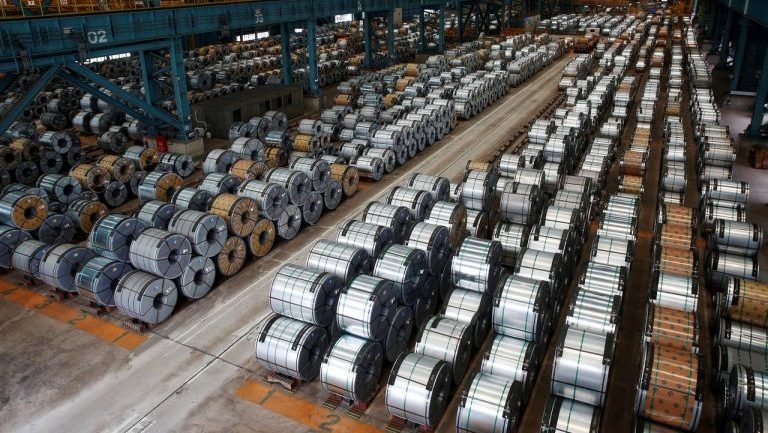Trump to impose steel tariffs
March 2, 2018 | Expert Insights

On Thursday, US President Donald Trump announced that the United States will soon be imposing global tariffs of 25% on steel imports, and 10% on aluminium. White house officials say that the details are still being clarified. Trump’s declaration resulted in a fall of equity in East Asia. A number of countries including key US allies have expressed dissatisfaction with these measures.
Background
President Trump is known to have a protectionist outlook on trade. On the campaign trail, he promised tariffs against countries such as China, whom he blamed for loss of jobs. He also criticized “bad” trade deals and “unfair trade practices” against America. He said that other countries were "dumping vast amounts of steel all over the United States, which essentially is killing our steelworkers and steel companies”.
Since taking office, the president has withdrawn from the Trans-Pacific Partnership, and initiated the renegotiation of the North Atlantic Free Trade Agreement. In recent months, experts have begun sounding the alarm about an impending trade war between US and China, the two largest economies in the world.
The US is a member of the World Trade Organisation (WTO). The WTO provides a framework for global trade agreements and resolves trade disputes between nations. The main principle of this agreement is non-discrimination, which implies that a member nation cannot impose unilateral tariffs against or grant special favours to individual nations. However, Section 232 of the US Trade Expansion Act of 1962 allows the country to “adjust the imports of an article and its derivatives” in the interest of national security.
The United States has a history of tariffs dating back to the 1700s. In 2002, tariffs imposed by Bush were thought to have cost the country 200,000 manufacturing jobs. They were lifted a mere 21 months after their imposition. In 2009, Obama imposed a 35% tariff on Chinese tires after lobbying from American companies. This reportedly saved over 1000 jobs. However, some studies have shown that the tariff cost the country $2 billion in total, including a retaliatory ban on American chicken parts by China.
The US is highly reliant on steel imports. American steel production has fallen from 112m tons to 86.5m tons since 2000. Employment provided by the industry has fallen from 135,000 jobs to 83,600 jobs.
Analysis
On Thursday, US President Donald Trump announced his intention to impose tariffs of 25% on imported steel and 10% on imported aluminium “for a long period of time”. The President cited “national security” in order to circumvent WTO commitments. The duties will reportedly be formalised next week.
Trump posted on Twitter: “Our Steel and Aluminium industries (and many others) have been decimated by decades of unfair trade and bad policy with countries from around the world. We must not let our country, companies and workers be taken advantage of any longer. We want free, fair and SMART TRADE!”
The tariffs are intended to restrict cheap metal imports from countries such as China, in order to boost the American steel industry. However, they will also hurt a number of US allies.
Numerous senior advisers, including Gary Cohn, director of the National Economic Council, have opposed such proposals in the past. US companies that are dependent on metal imports have done the same. Industries ranging from agriculture to construction have expressed concern that the tariffs will raise costs and result in a huge loss of jobs. Republican congressmen have stated that the measures will be detrimental to American businesses and economy, and are against free trade.
Trump’s announcement sent steel and aluminium equities crashing in East Asia. Japan and South Korea are two of the US’ biggest steel exporters. South Korean POSCO, and Hyundai Steel fell by up to 3.5%; Japan’s JFE holdings and Kobe Steel fell up to 3%; and China’s Baoshan Iron & Steel fell 3.5%. Shares of American automobile companies and other major metal consumers also dropped while steel makers made gains. The Dow Jones fell by 586 points.
Canada is the United States’ biggest steel exporter at 16%, followed by Brazil, South Korea, and Mexico. Japan is 7th and India is 10th. Canada and Japan expressed concern that steel exports from allied nations are considered a security threat. “Should restrictions be imposed on Canadian steel and aluminium products, Canada will take responsive measures to defend its trade interests and workers,” the Canadian minister of foreign affairs said. The EU’s European Commission issued a similar warning, criticising the “blatant intervention to protect U.S. domestic industry”.
India’s Steel Secretary told Reuters that only 2% of Indian exports go to the US and no “immediate dent” would result. She added that the “validity of Section 232 is stretched to be used as tariff barrier.”
Meanwhile, the Chinese Foreign Ministry stated, “The United States is disregarding the rules of the WTO, and China is dissatisfied with this… China will take proper measures to safeguard its legitimate rights and interests.”
Assessment
Our assessment is that these tariffs have the potential to negatively impact both the American and global economy. Numerous analysts have pointed out that Trump’s actions set precedent for an all-out trade war. The United States is the first country to use “security concerns” to circumvent WTO conventions, and there are concerns that this will result in a “domino effect” of protectionist policies. Trump’s “America first” trade strategy also runs the risk of alienating allies and damaging diplomatic ties. It is possible that the affected countries will take the issue to the WTO.








Comments